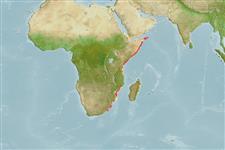>
Eupercaria/misc (Various families in series Eupercaria) >
Labridae (Wrasses) > Cheilininae
Etymology: Cirrhilabrus: Latin, cirrus = curl fringe + Greek, labros = furious (Ref. 45335); africanus: Named for the continent of Africa; noun in apposition.
Environment: milieu / Klimaatzone / Diepte / distribution range
Ecologie
marien rifbewoner; diepte 18 - 50 m (Ref. 114940). Tropical
Western Indian Ocean: Kenya and most probably in South Africa and Mozambique.
Grootte / Gewicht / Leeftijd
Maturiteit: Lm ? range ? - ? cm
Max length : 6.5 cm SL mannelijk / geslacht onbekend; (Ref. 114940); 4.4 cm SL (female)
Korte beschrijving
Determinatiesleutels | Morfologie | Morfometrie
Dorsale stekels (totaal) : 11; Dorsale zachte stralen (totaal) : 9; Anale stekels: 3; Anale zachte stralen: 9. This species is distinguished by the following characters: D XI,9; A III,9; pectoral-fin rays 15; pored lateral-line scales 15-18 + 6-7 (+1 over caudal-fin base); median predorsal scales 3-4; cheek with 5-7 scales in single row below the eye; uniserial row of suborbital pores; gill rakers 14-16. Morphometrics for terminal males: body depth 3.2-3.8 in SL; body width in depth 1.8-1.9; head length 3.0-3.1 in SL; the first 2 dorsal-fin spinous membranes moderately elongated and filamentous, 3.7-4.3 and 5.4-7.7 in SL, respectively; rounded caudal fin without extended upper and lower tips, 1.1-1.3 in HL; pelvic fins greatly elongated and broadly fan-like, reaching posteriorly to about middle of anal fin, 2.1-2.3 in SL; upper head and body reddish orange, lower head and body yellow to white, about three rows of small, well-spaced, bluish-to-lavender or reddish spots (not a stripe) across upper body; dorsal fin mostly dark to dusky red, divided mid-way out by a row of separated rounded spots (after first two membranes); caudal fin mostly dark with coppery-to-greenish sheen and numerous small pale spots and lines; the anal fin is mostly dark to dusky reddish; pelvic fins are greatly elongated and mostly dark to dusky reddish. (Ref. 114940).
Body shape (shape guide): fusiform / normal; Cross section: compressed.
Levenscyclus en paargedrag
Maturiteit | Voortplanting | Paaien | Eieren | Fecunditeit | Larven
Victor, B.C., 2016. Two new species in the spike-fin-fairy-wrasse species complex (Teleostei: Labridae: Cirrhilabrus) from the Indian Ocean. J. Ocean Sci. Found. 23:21-50. (Ref. 114940)
Status op de Rode Lijst van het IUCN (Ref. 130435: Version 2025-1)
Gevaar voor de mens
Harmless
Gebruik door de mens
Visserij: commercieel; Aquarium: Commercieel
Tools
Speciale rapporten
Download XML
Internetbronnen
Estimates based on models
Fylogenetische diversiteitsindex (Ref.
82804): PD
50 = 0.5000 [Uniqueness, from 0.5 = low to 2.0 = high].
Bayesian length-weight: a=0.01585 (0.00700 - 0.03587), b=2.95 (2.76 - 3.14), in cm total length, based on LWR estimates for this (Sub)family-body shape (Ref.
93245).
Trofisch niveau (Ref.
69278): 3.3 ±0.4 se; based on size and trophs of closest relatives
Weerstandsvermogen (Ref.
120179): Hoog, minimale populatieverdubbelingstijd minder dan 15 maanden (Preliminary K or Fecundity.).
Fishing Vulnerability (Ref.
59153): Low vulnerability (10 of 100).
🛈
